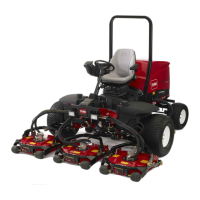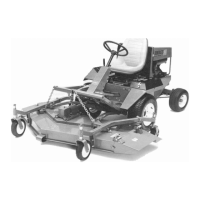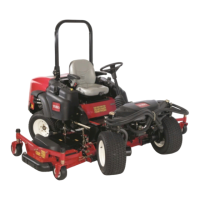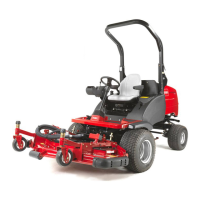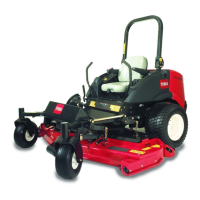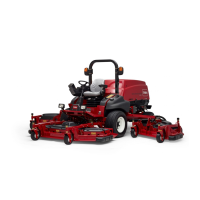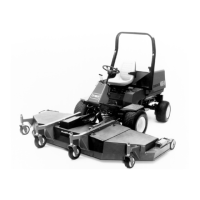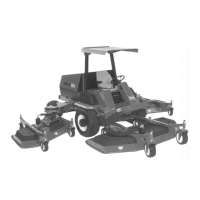Groundsmaster 4300--DHydraulic System Page 4 -- 32
Testing
The most effective method for isolating problems in the
hydraulic system is by using hydraulic test equipment
suchaspressure gaugesandflow metersinthe circuits
during various operational checks (see the Special
Tools section in this chapter).
Before Performing Hydraulic Tests
IMPORTANT: All obvious areas such as oil s upply,
oil filter, binding linkages, loose fasteners or im-
proper adjustments must be checked before as-
suming that ahydraulic componentis the sourceof
a problem.
Precautions for Hydraulic Testing
CAUTION
Failure to use gauges with expected pressure
(psi/bar)rating as listed intest procedures could
result in damage to the gauge and possible per-
sonal injury from leaking hot oil.
CAUTION
All t esting should be performed by two (2)
people.Onepersonshouldbeintheseattooper-
ate the machine and the other should read and
record test results.
WARNING
Keep body and hands away from pin hole leaks
or nozzles that eject hydraulic fluid under high
pressure. Do not use hands to searchfor leaks;
use paper or cardboard. Hydraulic fluid escap-
ing under pressure can have sufficient force to
penetrate the skin and cause serious injury. If
fluidisinjectedintotheskin,itmustbesurgical-
lyremovedwithinafewhoursbyadoctorfamil-
iar with this type of injury. Gangrene may result
from such an injury.
1. Clean machine thoroughly before disconnecting or
disassemblinganyhydrauliccomponents.Alwayskeep
in mind the need for cleanliness when working on hy-
draulicequipment.Contaminationcancauseexcessive
wear or binding of hydraulic components.
2. Review all test steps before starting the test proce-
dure.
3. Before testing,check all controllinkages forimprop-
er adjustment, binding or broken parts.
4. Allhydraulic testsshouldbemadewith thehydraulic
oil at normal operating temperature.
WARNING
Beforedisconnectingorperforminganyworkon
the hydraulic system, all pressure in the system
must be relieved. See Relieving Hydraulic Sys-
tem Pressure in the General Information section
of this chapter.
5. Put metal caps or plugs on any hydraulic lines left
open or exposed during testing or component removal.
6. Whenusinghydraulictester(pressureandflow),the
inlet and the outlet hoses must be properly connected
and not reversed to prevent damage to the hydraulic
tester or components.
7. Install hydraulicfittings fingertightand farenoughto
makesurethattheyarenotcross--threadedbeforetight-
ening them with a wrench.
8. Position tester hoses to prevent rotating machine
partsfromcontactinganddamagingthehosesortester.
9. After connecting test equipment, check oil level in
the hydraulic tank to make sure that oil level is correct.
10.When using hydraulic tester (pressure and flow),
opentesterloadvalvecompletelybeforestartingengine
to minimize the possibility of damaging components.
11.Theenginemustbeingoodoperatingcondition.Use
a phototac when performing a hydraulic test. Engine
speed can affect the accuracy of the tester readings.
Check actual speed of the pump when performing hy-
draulic flow tests.
12.After hydraulic test procedures have been com-
pleted,checkoil levelinthehydraulic tanktomakesure
that oil level is correct.
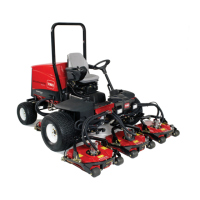
